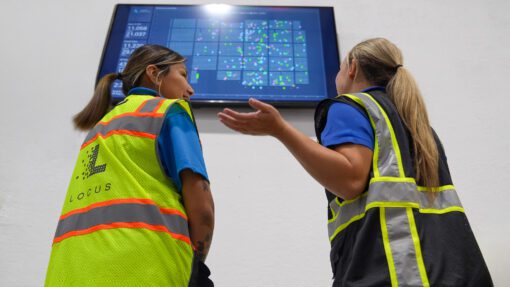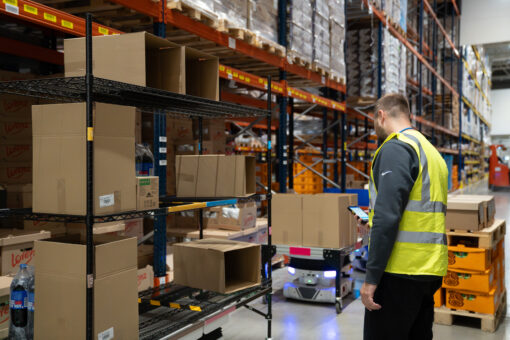WP: How to achieve 400 UPH with Locus Fast Pick
WP: How to achieve 400 UPH with Locus Fast Pick Download Now!
How to Choose the Right WMS: A Playbook for Smarter Warehouse Operations
Mary Hart, Sr. Content Marketing Manager

Choosing a Warehouse Management System (WMS) is one of the most important decisions any warehouse leader will make, and yet it’s surprisingly easy to get it wrong. Many teams rush into product demos, compare long feature lists, and pick the system that looks good on paper, only to find out months later that the real problem wasn’t the software at all.
Amit Levy, EVP of Sales and Strategy at Made4Net, joined me on the Warehouse Automation Matters podcast to share why a more grounded approach makes all the difference. A WMS should fit in with how your warehouse actually works and help it run even better as your business grows, adds automation, or expands into new channels.
Below is a step-by-step playbook inspired by that conversation, designed to help warehouse managers take control of the process and build lasting value, not just check a box.
Step 1: Map Where Things Fall Apart
A WMS alone won’t solve inefficient processes, and Levy made it clear that every successful implementation starts with a clear-eyed view of where the real problems lie.
Your move: Take a week to walk the floor, talk to your frontline teams, and trace how inventory moves through your operation. Pinpoint where time is wasted in the form of excessive walking, inaccurate counts, and manual double-checks, and quantify these gaps. If you don’t know where time and money are leaking now, you’ll struggle to measure ROI later.
Step 2: Build a Shared Vision
No WMS rollout works if it’s owned by just one department. The most resilient warehouse operations get operations leaders, IT, and executive sponsors on the same page early.
Your move: Host a cross-functional planning session to define exactly what you want to improve. Is it more accurate picks? Faster fulfillment? Easier integration with robotics? (Note: Locus Robotics easily integrates with Made4net’s WMS.) When everyone agrees on what success looks like, you’re far less likely to run into costly surprises halfway through implementation.
Step 3: Make Inventory Accuracy Non-Negotiable
According to Levy, inventory accuracy is still the single biggest priority. If the system can’t maintain precise, real-time counts down to slotting, expiration dates, or serial numbers, your entire fulfillment promise is at risk.
Your move: Dig into how each vendor’s system handles inventory data and ask how it reconciles mismatches, how it flags exceptions, and how easy it is for operators to fix issues without IT workarounds.
Step 4: Look Beyond User Manuals
A powerful WMS only works if people actually use it. Clunky interfaces and clumsy workflows turn even the best tools into shelfware.
Your move: Ask to see the system in action and not just a polished slide deck. Request a real demo showing how easy it is to set up a new workflow or adapt a picking rule. If the vendor’s answer is "We’ll customize that for you," take note as a flexible, intuitive system should empower your team to make everyday changes without constant coding or outside help.
Step 5: Demand Room to Grow
One thing many warehouses underestimate is how fast "good enough" stops being good enough. As order volumes climb, SKUs multiply, or your footprint expands to multiple sites, your WMS must be ready to keep up.
Your move: Verify whether the system has a proven track record of scaling with operations like yours. Ask about multi-site support, multi-client workflows (especially if you’re a 3PL or B2B/B2C hybrid), and how easily it integrates new automation technologies. Look for honest success stories about how current customers grew without needing a complete system replacement.
Step 6: Put People at the Heart of Implementation
Levy shared a clear truth: the toughest part of any WMS project isn’t the software like people might think. Instead, it’s the handoff from plan to execution and cross-functional ownership keeps projects from stalling.
Your move: Assign clear project owners in operations, IT, and project management. Schedule regular check-ins to catch issues before they grow and document lessons learned throughout the rollout since they’ll save you headaches when the next phase or site goes live.
Step 7: Keep Score in Real Time
Post-launch success comes down to measurement. Without clear KPIs, it’s easy to lose track of whether the system is delivering what it promised.
Your move: Define a short list of critical metrics before your go-live date. Common ones include lines picked per hour (LPH), order accuracy, and labor utilization. Put a system in place for tracking and reviewing these metrics weekly so you can catch red flags early.
Step 8: Choose a Partner, Not Just a Platform
Finally, remember that your WMS vendor shouldn’t just be a one-time software provider. They should be a partner who understands your evolving needs and helps you adapt over time.
Your move: Ask every vendor how they handle system updates, how they support AI, IoT, and automation integrations, and how often customers need custom development to get what they want. A strong partner helps you grow without locking you into endless workarounds.
Every warehouse is unique, but one thing holds true across the board: your WMS should strengthen your core processes, not weigh them down. Get the fundamentals right, build a team that owns the project together, and choose technology that grows and adapts alongside your business.




